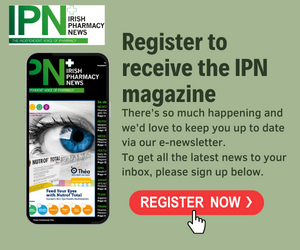Overview of Market: With pharmacists increasingly becoming the first port of call for many patients, it is useful to have basic knowledge of common eye disorders and their treatment. There has been 19% overall category growth in the past 2 years.

Dry eye product sales have substantially increased in the past 2 years by 25%, which is believed to be due to increased screen time due to many working from home as well as the increase in using hand-held devices instead of watching television.
Pharmacists should demonstrate the proper use of ophthalmic drops to patients so that the medication is applied correctly. Leaflets that instruct patients on how to instil eye drops should be made readily available and should be used to reinforce the explanation.
There has also been an increase in recent years in the number of eye care supplements available over the counter in pharmacies. By far the most common OTC eye supplements are those used to prevent and slow the progression of Age-related Macular Degeneration (AMD).
Dry Eye Syndrome
Dry eye syndrome is due to decreased production of tears or excessive tear evaporation and caus-es discomfort and soreness. Patients may also complain about a sensation of feeling grit in their eye. Underlying causes of dry eye include Sjögren’s syndrome, aging, staring at a screen for too long, blinking problems, and environmental factors.
Additionally, patients taking such medications as oral contraceptives, antihistamines, and beta-blockers may experience dry eyes.
Dry eye syndrome can be managed using non-prescription artificial tear products. Many OTC products are available, and preservative-free formulations are recommended if the patient experiences itching and irritation with the drops. Dryness can also be prevented by the use of humidifiers.
Age-related Macular Degeneration (AMD)
AMD is a leading cause of vision loss. It’s mainly associated with aging, but some forms of macular degeneration affect younger people as well.
AMD occurs when there’s deterioration of light-sensitive cells in the macula area of the retina. This is the part of the eye responsible for:
• recording what we see and sending the information to our brains
• seeing fine detail
• focusing
Other Common eye conditions presented in community pharmacy
• Red Eye
• Allergic Conjunctivitis
• Bacterial Conjunctivitis
• Subconjunctival Haemorrhage
• Blepharitis
• Floaters
• Styes
• Watery Eyes
• Foreign Body in the Eye
• Meibomian Cysts (Chalazia)
How we can support patients
Questions to ask during an eyecare consultation in the pharmacy (Elton M. Ocular conditions from A to Z (ii). Pharm J. 2007;278:255-258):
• How long have you had this problem?
• Have you had this problem before?
• What is the pattern of occurrence of this problem?
• Has it gotten worse or better over time?
• Is there any pain?
• Is there any discharge?
• Is your vision affected?
• Do you know what the problem could be? Is there an obvious cause?
• Have you been using a computer screen for prolonged periods of time?
Symptoms that require immediate referral (Elton M. Ocular conditions from A to Z (ii). Pharm J. 2007;278:255-258):
• Pain in the eyes
• Blurred or distorted vision
• Worsening symptoms
• Any doubt about the diagnosis
• No improvement with any OTC medications previously used.
What Vitamins and Nutrients may help Eye Health?
Lutein and zeaxanthin
Lutein and Zeaxanthin are carotenoids. Carotenoids are pigments found in plants and in your reti-na. Supplementing these pigments helps increase their density in your retina. They also absorb high-energy blue and ultraviolet light that can damage your eyes. Dark green leafy vegetables are the primary source of lutein and zeaxanthin, as well as other colourful fruits and vegetables like broccoli, corn, peas, persimmons and tangerines.
Omega-3 fatty acids
Photoreceptors cells in the retina contain a large quantity of omega-3 fatty acid. It’s believed that docosahexaenoic acid (DHA), a type of omega-3 fatty acid, helps in the development of retinal cells. It’s also thought to have a role in reducing inflammation and helping cells of the retina and the cornea heal and regenerate after damage due to light exposure and aging. Salmon, tuna and other coldwater fish are the best sources of omega-3 fatty acids and can help reduce inflamma-tion, enhance tear production and support the eye’s oily outer layer.
Zinc
Also found naturally in your eyes, zinc is a powerful antioxidant that protects against cell damage. Zinc plays a vital role in bringing vitamin A from the liver to the retina in order to produce melanin, a protective pigment in the eyes. Impaired vision, such as poor night vision and cloudy cataracts, has been linked to zinc deficiency. For natural dietary sources of zinc, try red meat, oysters and other shellfish, and nuts and seeds.
Vitamin B1 (thiamine)
Vitamin B1 is essential for the health of your eyes. Known as one of the “anti-stress” B vitamins, vitamin B1 reduces inflammation.
Vitamin C
Vitamin C may lower the risk of developing cataracts and when taken in combination with other essential nutrients, it can slow the progression of age-related macular degeneration and visual acu-ity loss. For your daily dose, try incorporating oranges, grapefruit, strawberries, papaya, green peppers, and tomatoes into your diet.
View the August IPN magazine here
To recieve the monthly IPN magazine, click here










